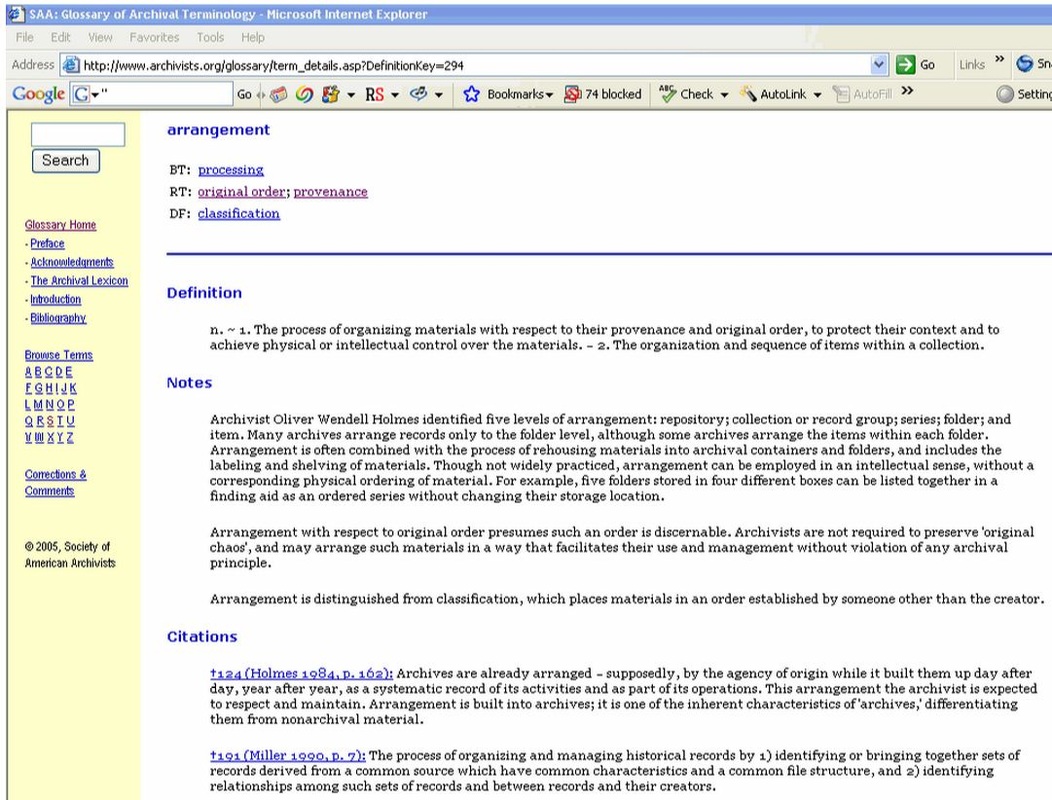DEFINITION
Establishing intellectual controls at an archival repository is a simultaneous 4-aspect process of:
a. analysis
b. selection
c. arrangement, and
d. description
For the purposes of this lesson, we'll focus just on the last two. See if you can get a clear understanding of arrangement and description, and the distinction between these two archival terms.
Establishing intellectual controls at an archival repository is a simultaneous 4-aspect process of:
a. analysis
b. selection
c. arrangement, and
d. description
For the purposes of this lesson, we'll focus just on the last two. See if you can get a clear understanding of arrangement and description, and the distinction between these two archival terms.
Thus, when archives use the word arrangement they are referring to the scheme by which groups of items and collections are ordered to reveal their content and significance. Now for the related term, description:
EXAMPLES OF THIS KEY AT WORK:
Look at an application of arrangement and description in a processed archival collection.
Look at an application of arrangement and description in a processed archival collection.
PRACTICAL HOW-TO’S:
An archival rule of thumb is to leave materials in their original order (it it's a sensible order -- as we discussed in Archival Key #3) and let your description lead you into the material according to the organizational structure of the institution.
Think of the researcher, who is generally using Zipf's Law of Least Effort. Someone has described that law as follows:
"...most researchers suffer from (or perhaps enjoy) an astonishing degree of inertia. This is not quite the same thing as saying that short-term rewards are preferred to long-term rewards. It is more like Zipf's law of least effort. It has been shown that, given a choice of going next door with a small probability of obtaining relevant information, or indeed much information at all, and walking a hundred yards with a much higher probability of success and quantity, people go next door." (Source: M. B. Line, On the Design of Information Systems for Human Beings. Aslib Proc. 22: 329, July 1970, quoted in the Bulletin of the Medical Library Association 59 (2) April 1971, page 303.)
This is no doubt why search engines like Google have become so popular. They make research so easy -- one-stop searching, right at your fingertips! And that is why many archival institutions today expend so much of their staff resources to placing descriptions of their collections on the Internet.
An archival rule of thumb is to leave materials in their original order (it it's a sensible order -- as we discussed in Archival Key #3) and let your description lead you into the material according to the organizational structure of the institution.
Think of the researcher, who is generally using Zipf's Law of Least Effort. Someone has described that law as follows:
"...most researchers suffer from (or perhaps enjoy) an astonishing degree of inertia. This is not quite the same thing as saying that short-term rewards are preferred to long-term rewards. It is more like Zipf's law of least effort. It has been shown that, given a choice of going next door with a small probability of obtaining relevant information, or indeed much information at all, and walking a hundred yards with a much higher probability of success and quantity, people go next door." (Source: M. B. Line, On the Design of Information Systems for Human Beings. Aslib Proc. 22: 329, July 1970, quoted in the Bulletin of the Medical Library Association 59 (2) April 1971, page 303.)
This is no doubt why search engines like Google have become so popular. They make research so easy -- one-stop searching, right at your fingertips! And that is why many archival institutions today expend so much of their staff resources to placing descriptions of their collections on the Internet.
Resources ~ Books:
- Hunter, Gregory S., Developing and maintaining practical archives: a how-to-do-it manual (New York: Neal-Schuman Publishers, 2nd edition, 2003). Call number: CD950 .H86 2003
- Roe, Kathleen, Guidelines for arrangement and description of archives and manuscripts: a manual for historical records programs in New York State (Albany, N.Y.: University of the State of New York, the State Education Dept., New York State Archives and Records Administration, 1991). Call number: Z695.2 .R64 1991
- Miller, Fredric, Arranging and describing archives and manuscripts (Chicago: Society of American Archivists, 1990). Call number: Z695.2 .M55 1990
- Society of American Archivists, Describing archives: a content standard [DACS] (Chicago: Society of American Archivists, 2004). Call number: Z695.2 .S625 2004
YOUR PRACTICAL APPLICATION:
You decide how best to apply what you've learned about arrangement and description.
You decide how best to apply what you've learned about arrangement and description.



